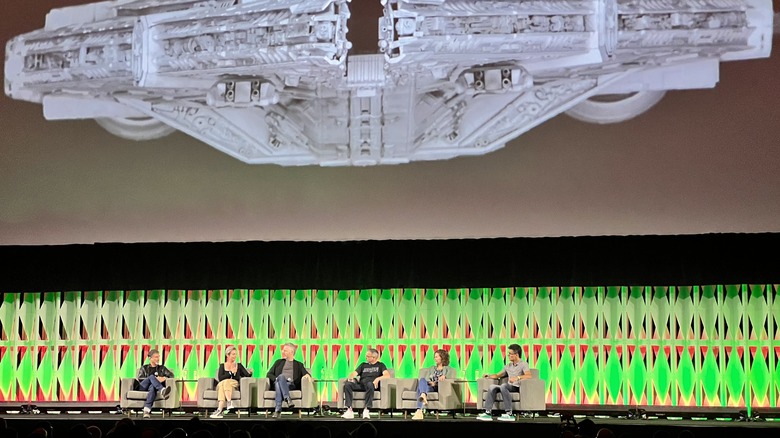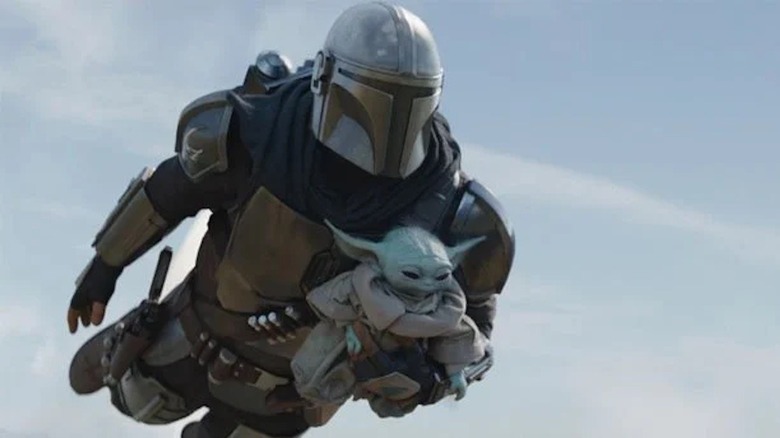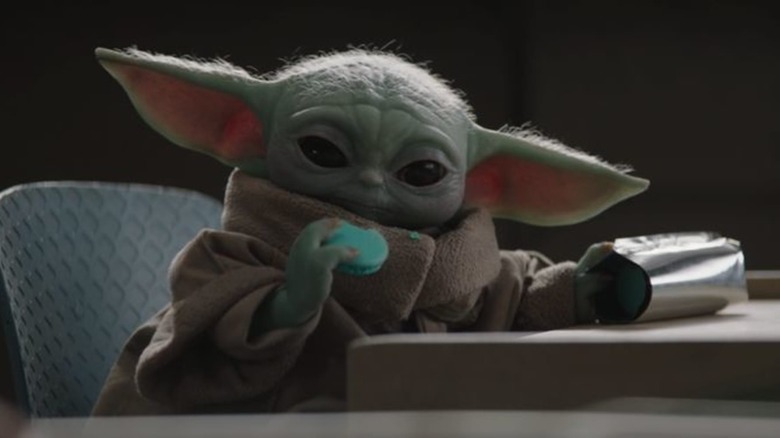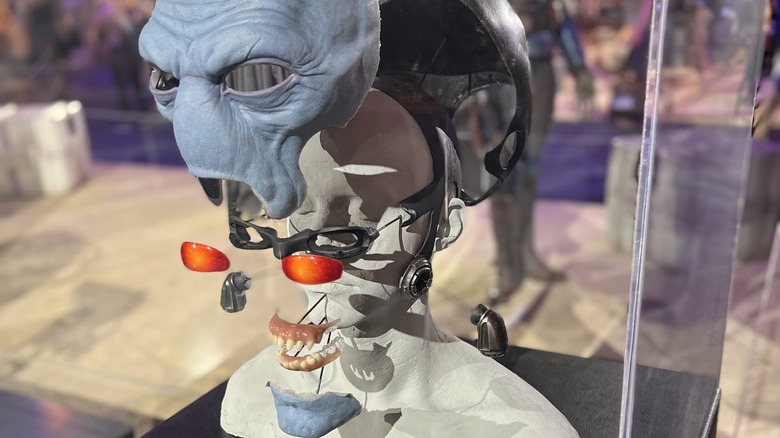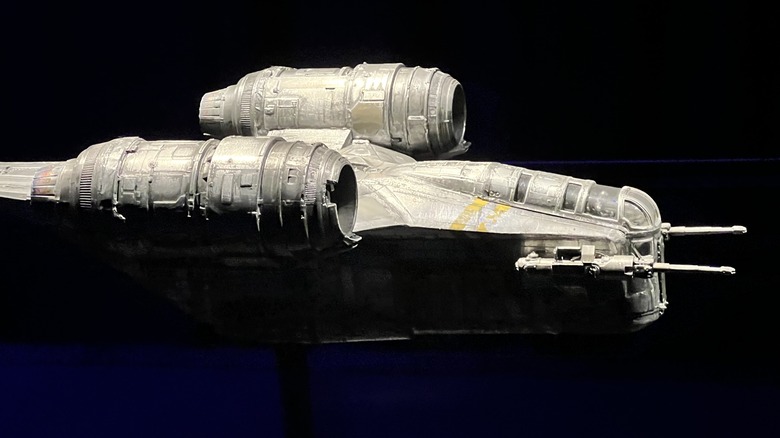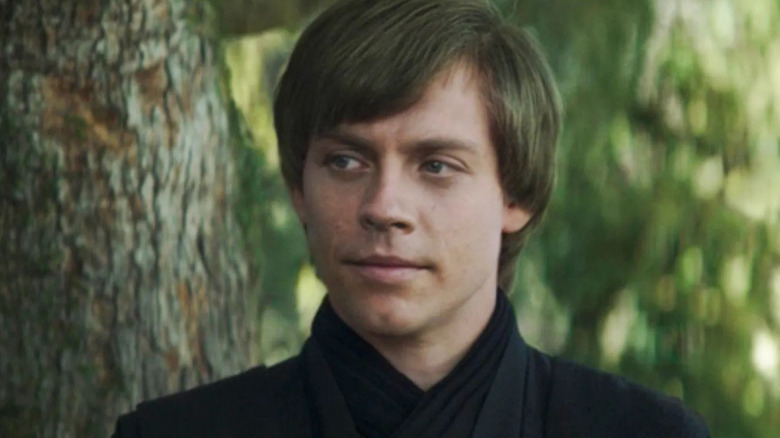Star Wars Celebration: Behind The Scenes Of The Mandalorian And Book Of Boba Fett
Star Wars Celebration is a place where the makers of the magic are given their proper due, and the effects wizards behind "The Mandalorian" and "Book of Boba Fett" are no exception. On Saturday at the show, following up the Mando+ extravaganza, the stage was turned over to the crew behind the scenes.
Vanity Fair writer Anthony Breznican hosted the panel and brought out Janet Lewin (the manager of Industrial Light & Magic), Richard Bluff (VFX supervisor on "The Mandalorian"), Bonnie Wild and Matthew Wood (from Skywalker Sound), John Rosengrant (from Legacy Effects), and one of the puppeteers for Baby Yoda aka Grogu. Here's what they had to say about making the shows and bringing this part of "Star Wars" to life.
Making the impossible come to life
Like any proper "Star Wars" show, the chief challenge of "The Mandalorian" was that no one was quite sure the technology would work before they had to begin filming.
"I was asked to get into Star Wars television back when George Lucas was his show. Back in 2007-8, George felt like he needed a breakthrough to achieve the stories. Those stories were never made," Richard Bluff said of his experience. The technology simply wasn't there to do movie-quality "Star Wars" on a TV size and scale. But he offered to get involved if Lucasfilm got back into that arena.
The special effects wizards at ILM were gearing up to begin production of "The Mandalorian" in October of 2018, but by June of that year, they still had no idea if they could do it. Janet Lewin, one of the heads of ILM, found it entertaining, saying, "The most fun part of making the first season of "The Mandalorian" was putting all of these geniuses in the room and making the impossible happen."
The team, led by Bluff, showed up at their soundstage that June and started throwing game engine VFX work and pointing a camera at it, hoping it would work. They captured photography from "The Force Awakens" and other movies and did their best to make it look right, because it would save so much money to do it with their Stagecraft.
Lewin said there was simply no way to stay on budget with the Mandalorian's helmet alone, and the helmet would have needed to be CG if they didn't have the technology, because otherwise they would need to take out all of the green-screen reflections.
But it was James Cameron who let them know they had a winner on their hands. Busy filming the sequel to "Avatar" on the next stage over, he came in to watch the tests. "Yeah, that's really good," he told them, and then asked questions about the compositing. When they showed him that it all of the photography had been done in-camera on the Stagecraft, he took his glasses off, leaned into the screen, and said, "Really? That's amazing."
Bluff said this was the moment they knew it would work.
Rosengrant added that he started his career on the first "Terminator" and says definitely that James Cameron is one of the most discerning eyes in VFX and his sign-off meant something important.
They were going to be able to pull off the impossible.
The Child
ILM started building the computer generated character for Grogu while Legacy went to work on a puppet that would be used for further shots. Jon Favreau wanted to control the puppet in post-viz, so ILM built him an iPhone app that would allow him to do it. According to Bluff, the app would read Favreau's facial features and allow him to manipulate the performance so that he could turn that over to the final animators and get the emotion right.
But Rosengrant really thought they could do it with a puppet. "Any time you can get a reaction from an actor, if we could have that little child be there and be real, then just maybe they could make it work."
He put together a test two weeks before shooting on "The Mandalorian" began and made a how-to video about how to shoot Grogu. It was that test Favreau saw that changed his mind, and history was made with the Grogu puppet.
Rosengrant said everyone was taken with the Child. Everyone cradled it like a real child when they met it, from Rosario Dawson to George Lucas. But it was Werner Herzog who was most taken with the puppet:
"I was performing there with the team when Werner met the baby for the first time. Werner did a lot to help propel the baby into stardom. The first AD told me to have Grogu in for an eyeline for Werner's closeups. He had an affection for it and it was very real and when you start filming, it was turned off because [Grogu] wasn't in the shot. Werner stopped them and asked if it was brain dead."
Herzog made them turn the puppet on and ensure it was okay for his reactions.
Two other interesting tidbits that came from the panel as far as the Child goes: first, Rosengrant assures everyone that it did not cost $5 million. When Favreau told that to the Stormtroopers punching the baby, it was just an exaggeration to sell his point. The second was that although the puppet has feet, we rarely see them because, according to Rosengrant, "Jon doesn't like his feet."
Cad Bane
Moderator Anthony Breznican turned the conversation to Cad Bane and his return in "The Book of Boba Fett," and Rosengrant spoke of going back to the cartoon to figure out how to bring the cartoon character to life. He knew of an actor he'd worked with before with the right body type and pantomime ability named Dorian Kingi. Kingi allowed them to do Cad Bane with makeup and made it very simple. Then they brought Corey Burton in to do the voice, which it really brought it to life.
Matthew Wood talked about how Corey Burton recorded Bane's lines from his house during the lockdown. He said they did a fair amount of post-production in "Star Wars: The Clone Wars" to put Bane's breathing apparatus in the sound of his voice, but they cut down on that for the live action and let Corey Burton's voice really sing on its own for "The Book of Boba Fett."
Bonnie Wild recalled on the panel the moment it came together. "That moment when he shows up, we wanted to create this real tension. Dave Filoni was there for recording that scene and he was very into it. When you see Dave enjoying it, there's a real sense of thinking we did it right."
Miniatures
The use of miniatures in "The Mandalorian" had not been an initial option when they started work on the show.
"During season 1," Bluff recalled, "Jon Favreau made a passing comment about making miniatures. He made that comment again a couple of weeks later." Bluff suggested they build a model and at least light it and use it as a reference. But then they called John Knoll and told him about it, he just went home and starting building a motion control rig in his garage to film the miniature with. "Then all of a sudden we were building miniatures in "Star Wars" again."
There was a cost-savings to having miniatures teams working on the show, too, according to Lewin. "We were able to photograph the miniatures, put them on the Volume, and then film actors against those miniatures on the screen."
"Then, we started building environments that way, too," Bluff said. Part of the race to get that content on the screen was to spread the work out with other teams, including those teams who would make those miniatures. The use of miniatures allowed them to stay on schedule for the production.
Luke Skywalker
You can watch more about how Luke Skywalker came to life in "The Mandalorian" and "The Book of Boba Fett" in the behind-the-scenes documentaries on Disney+, but on this panel the team talked about how and why they chose actor Graham Hamilton for the role in the first place.
They didn't have the deep fake technology working for "The Mandalorian," but when they got to the beginning of "The Book of Boba Fett", they pulled the team from ILM into the casting review process. Using ILMxLab and a fake motion control project as a cover, they put out a wide casting call and maintain their secrecy. And that's where they found Graham Hamilton. They did a face-swap on Hamilton's casting video and proved that he had they physical characteristics and acting chops they what he needed to do.
Hamilton was gobsmacked when Jon and Dave talked to him on Zoom to tell him he wasn't going to be on the fake project, but was actually going to be Luke Skywalker.
The technology advanced fast enough for "The Book of Boba Fett" that they had a 75% completed version by the next day after filming, so they could look at dailies and make adjustments on the fly.
"The Mandalorian" and "The Book of Boba Fett" are both currently streaming on Disney+. The third season of "The Mandalorian" premieres in 2023.
